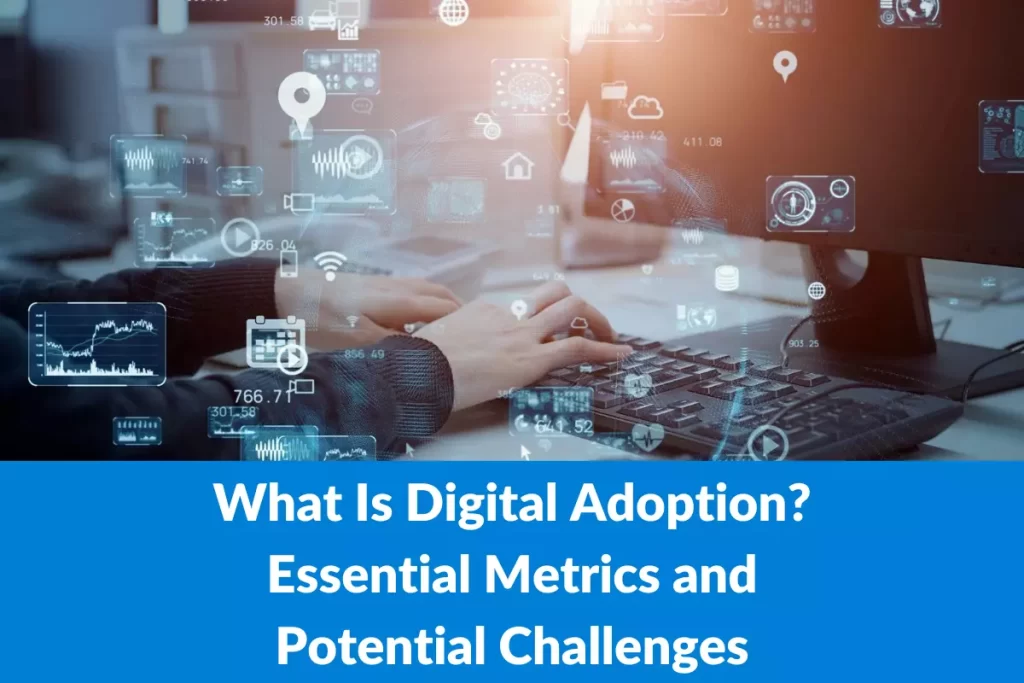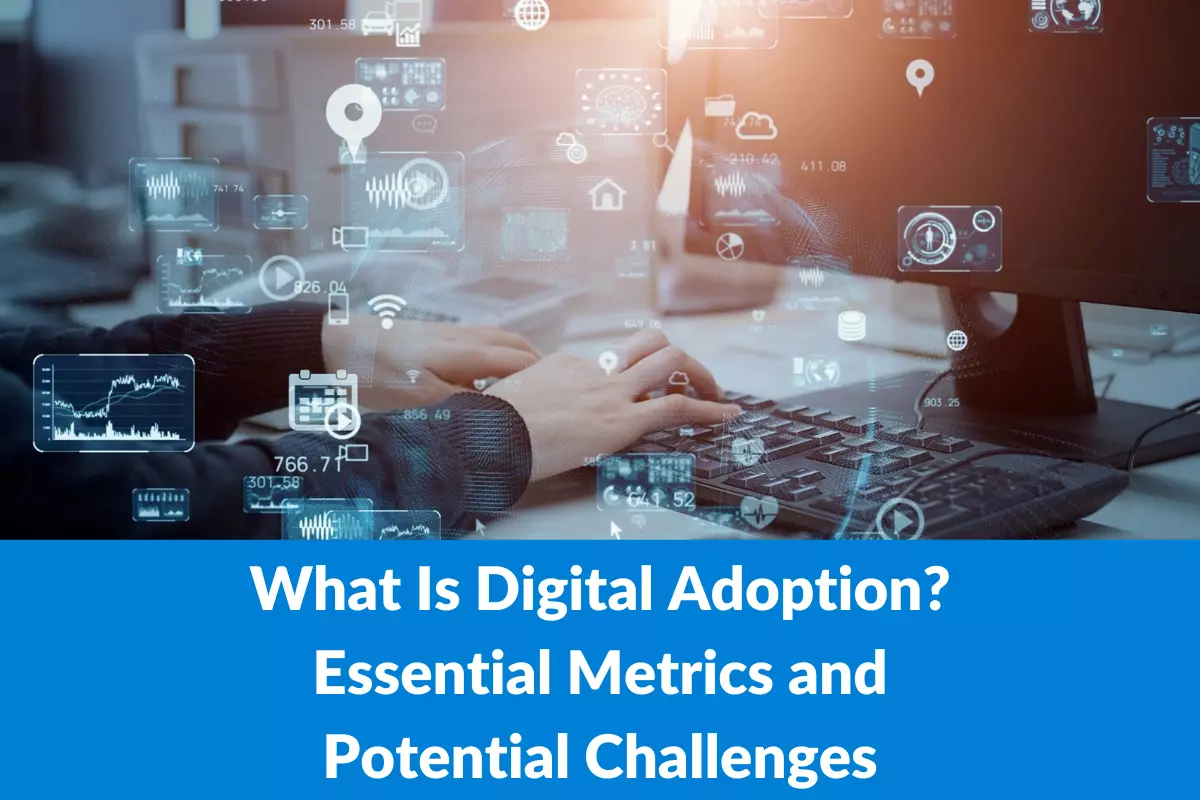What is digital adoption? Digital adoption is a term used to describe incorporating new digital technologies into an organization. When done correctly, digital adoption can help improve organizational efficiency and communication.

However, several potential challenges can impact the success of a digital adoption initiative. By understanding the essential metrics associated with digital adoption, you can take steps to ensure your organization’s success.
What is digital adoption?
Organizations are more eager than ever to use innovative software and solutions to streamline operations, boost output, and maximize return on investment. It makes it possible for the organization to convert from the old ways of doing things to the new ones.
Digital adoption is the capacity to use an application, piece of software entirely, or instrument and the ability to do various digital tasks. If a company’s software and tech stack are not utilized to their fullest extent, digital adoption cannot be achieved. In a corporate setting, this occurs when a company facilitates the widespread acceptance of new technology by its employees or clients throughout the installation.
Benefits of digital adoption
The critical advantage of boosting digital adoption among your staff and clients is maximizing ROI for new technology. Businesses typically use digital adoption strategies to increase productivity, cut costs, or address other issues related to their operations.

However, the software will only benefit the company if the employees utilize it fully. Adoption of digital technology occurs when a firm fully adopts and benefits from new technology.
Here are the main advantages of digital adoption:
- Shortening the time to value for new clients by facilitating their “aha” experience.
- Increasing internal efficiency generally.
- Ensuring partner businesses are aware of all the advantages of using your product.
- Going through a lot of developments in your field.
- Eliminating tech-related irritability among staff or clients.
- Lowering support tickets, eliminating the need for internal technical support teams, and training your staff to be technology experts.
Measurement metrics of digital adoption
Besides understanding what digital adoption is and its benefits, it is vital to know the metrics that can help businesses determine whether or not their digital adoption planning needs to be altered based on how well it is performing.
They also allow you to monitor development and get a picture of how things stand. Here are some crucial digital adoption metrics that will assist businesses in achieving their objectives.
Active users
Adopting sustainable technology, which is required for effective digital adoption, is one of the crucial KPIs for monitoring the active usage of your digital assets. This can be determined by comparing the number of licenses paid to the total number of product users.

User engagement & active usage
If staff aren’t participating as much as organizations would like them to, it’s probably because the technology isn’t reliable enough to force them out of their current work habits. Without employee involvement, no matter how capable your software is or how well-thought-out your digital adoption strategy is, it is all for waste.
Productivity
Adopting the proper solutions will significantly increase output, performance, and productivity, which will help you achieve your company’s overall goals and objectives. Furthermore, productivity measurement is one of the easiest metrics for your digital transformation measurement plan.
It is based on a comprehensive model that quantifies the output value in relation to the time and resources invested or the return on investment.
Revenue
Similar to how productivity is examined, revenue is also reviewed as part of a digital adoption measuring plan. You contrast recent data with records made before implementing the system. From there, it is simple to determine whether a piece of technology contributes to revenues, especially considering its initial purchase price and long-term return on investment.
Potential digital adoption challenges

Employees are reluctant to adopt new technologies
Not all employees will welcome digital developments, such as introducing new CRM software or digitizing paper records. Some workers can be keen on maintaining the status quo because they think digital technology will be disruptive rather than beneficial. Even if jobs and businesses have changed, many are still resistant to change. Employee resistance to change ultimately makes it challenging to promote digital adoption.
Inadequate onboarding for digital tools
Unfortunately, conventional ways of educating personnel to use these tools, like classroom instruction and unstructured knowledge bases, may not be sufficient to prepare them to use such complicated software. Lack of onboarding leads to an absence of understanding of the main program capabilities and low adoption.
Measurement of user adoption is tough
Companies are unaware of which app features are utilized frequently by employees, which features they might require assistance with, and which app features are never used.

Adopting new software becomes one of the major problems for organizations in digital adoption if there is no technique to closely monitor user adoption for new solutions.
So what is an effective tool to make digital adoption smooth?
Epilogue Opus – Your advanced digital adoption tool for the digital transformation
Epilogue Opus is an advanced digital adoption tool that helps businesses drive digital transformation. It provides a suite of tools and services that helps companies to adopt new digital technologies and processes and to accelerate their digital transformation journey.
Epilogue Opus offers a complete set of tools for digital transformation, including a digital adoption platform, a digital experience management platform, and a range of services such as training, consulting, and implementation. For example:
- In-application advisor – Opus provides in-application assistance to encourage user adoption and competency. Users choose the instruction format that best suits them, which helps shorten the time needed to become proficient.
- Adoption insights – Through the corporate tech stack, you may gather helpful information about how users and teams utilize the platforms and what training they need. Making data-driven decisions on application upgrades and deployments is possible with the help of this extra business intelligence. It can be used to verify the ROI of enterprise applications.
In conclusion
The adoption of digital technologies is overgrowing, but potential challenges could still impact adoption rates. To understand and address these challenges, it’s important to track key metrics related to digital adoption. By monitoring these essential metrics, businesses can ensure they do everything possible to encourage people to adopt digital technologies.
We hope you have a clear view of digital adoption through the article. And please don’t forget to contact us, Epilogue Systems, if you have any questions about this topic!





